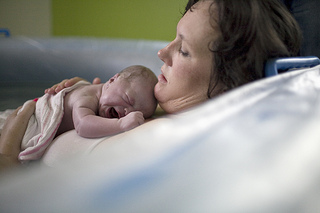The Wax Home Birth Meta-Analysis: An Outsider's Critique
By: Sharon Muza, BS, LCCE, FACCE, CD/BDT(DONA), CLE | 0 Comments
Today's post is a fascinating interview that took place between Rebecca Dekker, PhD, RN, APRN of Evidence Based Birth and Kyoung Suk Lee, PhD, MPH, RN, APRN. Rebecca asked Dr. Lee to provide a review of the Wax Home Birth Meta-Analysis, as an 'unbiased outsider', but highly skilled researcher. Dr. Lee's comments and critique are fascinating and provided me with many further thoughts. Please enjoy Rebecca's interview and share your comments. - SM

http://www.flickr.com/photos/eyeliam/7353095052/
Shortly after starting my website,www.evidencebasedbirth.com, I had several people ask me if I could write an article about the research evidence on home birth. However, I was hesitant to do so for several reasons. Mainly, I was worried that I could not look at the evidence in an objective manner. My husband and I had recently chosen a home birth for our second child. I was worried that it would be difficult to objectively examine the research evidence on home birth, given my personal experience. The blogosphere is full of people who are strongly pro-home birth or anti-home birth, and their evaluations of the evidence are usually written through the lens of their own biases. I didn't want to add to the plethora of biased articles already out there.
Then I had a sudden burst of inspiration. What if I asked one of my colleagues - who has no biases about childbirth - to review the home birth literature for me? In particular, I wanted to find someone who could review the Wax home birth meta-analysis (Wax, Lucas et al. 2010) and give me a fair assessment of its scientific value.
I chose the Wax meta-analysis for this review because in 2011, the American Congress of Obstetricians and Gynecologists emphasized the results of the Wax study in its official statement on home birth. Their statement said: 'Women inquiring about planned home birth should be informed of its risks and benefits based on recent evidence. Specifically, they should be informed that although the absolute risk may be low, planned home birth is associated with a twofold to threefold increased risk of neonatal death when compared with planned hospital birth.'(ACOG, 2011)

Dr. Kyoung Suk Lee, PhD, MPH, RN, APRN
It did not take me long to figure out who I would ask to review the Wax study. Dr. Kyoung Suk Lee is considered by her colleagues to be a rising star in the field of cardiovascular research. She recently graduated with a PhD in Nursing, and she just accepted a job at a research university. People who work with Dr. Lee say that she is extremely intelligent, hard-working, and a future leader in her field. Dr. Lee's expertise has been recognized with research awards from the Heart Failure Society of America, the Society for Heart-Brain Medicine, and the Cleveland Clinic Heart-Brain Institute, among others. She has published her work in nursing and cardiology journals. Furthermore, I knew that Dr. Lee did not have any biases about childbirth, home birth, or hospital birth. I asked Dr. Lee if she would be willing to review the Wax meta-analysis for me, and she kindly agreed.
What follows is my interview of her about the study and its results (RD in bold, KSL unbolded).
Do you have any biases or conflicts of interest related to home or hospital birth?
I do not have any biases related to home or hospital birth.
Could you summarize the methods and results of the Wax study?
The purpose of this meta-analysis was to compare maternal and neonatal outcomes between planned home-and hospital-births.
Using an electronic database search and bibliography search, the authors retrieved 237 articles and included 12 articles in their meta-analyses. Of 12 articles included, 3 were conducted after 2000 while 9 were conducted before 2000. Of 12 articles, 2 were conducted in the US (one was a retrospective design) while 10 were conducted outside US.
Women in the planned home birth group had better maternal outcomes than women in the planned hospital group. They had fewer interventions such as epidurals and episiotomies, and lower morbidity (infection, 3rd or 4th degree lacerations, hemorrhages, and retained placenta). There were no differences in cord prolapse between the two groups.
For neonatal outcomes, babies born to women in the planned home birth group were less likely to experience prematurity and low birth weight. However, babies born to women in the planned home birth group were more likely to experience neonatal death compared to women in hospital birth.
What is the difference between neonatal and perinatal mortality? What does this have to do with the results?
Based on the definitions given by the authors, neonatal mortality was defined as 'death of live born child within 28 days of birth.' This is a subset of an overall outcome - perinatal mortality, which was defined as 'stillbirth (of at least 20 weeks or 500g) or death of live born child within 28 days of birth.'
According to the authors, there were no differences in perinatal death (the overall outcome) between planned home birth and hospital birth groups. However, homebirth was associated with 2 times higher risk for neonatal death (the subset of deaths occurring 28 days after birth) in all infants and 3 times higher risk for neonatal death in infants who did not have any congenital birth defects.
Interestingly, if you look at page 243.e3, the authors did a sensitivity analysis. In this analysis, they excluded the studies that had home births that were not attended by certified midwives or certified nurse midwives. In this analysis, they found that there were no differences in neonatal deaths between the home birth and hospital birth groups. This means that in the studies in which midwives with certification of some kind attended home births, the outcomes were the same except there was no increase in the neonatal death rate. In my opinion, we have to pay attention to results of sensitivity analyses because this allows us to see the results based on studies which were definitely known to be eligible or clearly described their methods and outcomes.
What is your opinion on the scientific rigor of this meta-analysis?
One thing that was strange to me is the odds ratios (ORs) in the tables. For example, in table 2, under morbidity, the percentages of infection between home births and hospital births were 0.7 vs. 2.6 (its OR was 0.27) while percentages of perineal laceration were 42.7 vs. 37.1 (its OR was 0.66). To a researcher, these numbers don't make sense.
Many of the studies included were older (half of the studies were conducted more than 20 years ago) so results may not reflect the current practice at home births or hospital births.
The authors did not provide detailed information on how they evaluated the quality of studies included, although they cited a paper describing the method of study evaluation. This makes it difficult if not impossible to determine whether the studies they included were of good or poor quality.
The authors mentioned that women with high risks would prefer hospital births so that it would expect that home births have better outcomes than hospital births in some maternal and neonatal outcomes. If this was a concern, I wonder why the authors didn't just focus on only the studies that used matching methods, in order to minimize confounding factors.
What is the difference between relative risk and absolute risk, and how does that apply to women who want to have a home birth?
Absolute risk is the probability of something occurring. They may be expressed as percentages or ratios. For example, neonatal mortality rate in the United States is 2.01 per 1,000 live births. This is .201 percent (2.01/1000 = .201/100).

http://www.flickr.com/photos/mikeporcenaluk/3789756395/
Relative risk is a comparison between different risk levels, such as the neonatal mortality rate of home birth compared to the neonatal mortality rate of hospital birth. The researchers found that there was a higher relative risk in neonatal mortality at home births compared to hospital births, but the overall absolute risk for both was small.
How can women know whether the Wax study results would be applicable to their own individual situation?
Meta analysis is one way to generalize findings from different studies. However, women and clinicians should interpret these results cautiously because the studies included were very different from one another and some of the studies included may not have been of good quality. Also, it would be important to note that the overall neonatal death rate that they report reflects home births that were attended by midwives as well as those that may not have had any kind of certified midwife present.
Because this study seems to have some flaws, the conclusion is tentative. I do not know if this article has any implications for pregnant women.
What do you think is the value of asking someone with no conflicts of interest to evaluate controversial research? Does Dr. Lee's even-handed critique make you view the results of this study any differently? How do you feel about Dr Lee's conclusion that the study's results are tentative, and that the Wax study might not have any implications for pregnant women? Please share your thoughts and comments with other readers.
References
(2011). 'ACOG Committee Opinion No. 476: Planned home birth.' Obstetrics and gynecology 117(2 Pt 1): 425-428.
Wax, J. R., F. L. Lucas, et al. (2010). 'Maternal and newborn outcomes in planned home birth vs planned hospital births: a metaanalysis.' Am J Obstet Gynecol 203(3): 243 e241-248.
About Rebecca Dekker
 Rebecca Dekker, PhD, RN, APRN, is an Assistant Professor of Nursing at a research-intensive university and author of www.evidencebasedbirth.com. Rebecca's vision is to promote evidence-based birth practices among consumers and clinicians worldwide. She publishes summaries of birth evidence using a Question and Answer style.
Rebecca Dekker, PhD, RN, APRN, is an Assistant Professor of Nursing at a research-intensive university and author of www.evidencebasedbirth.com. Rebecca's vision is to promote evidence-based birth practices among consumers and clinicians worldwide. She publishes summaries of birth evidence using a Question and Answer style.
Published: October 23, 2012
Tags
ResearchRebecca DekkerACOGHome BirthLabor/BirthMaternal Infant CareInterviewsMeta-AnalysisHome Birth vs. Hospital BirthEvidence Based TeachingLearner EngagementIs Home Birth Safe?Kyoung Suk LeePersonalizeWax study